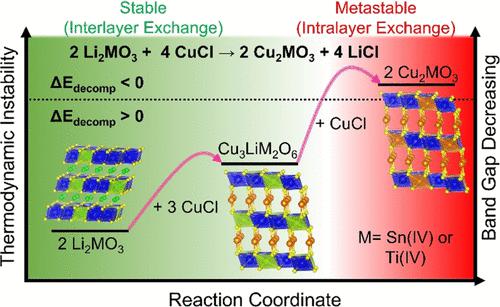当前位置:
X-MOL 学术
›
Chem. Mater.
›
论文详情
Our official English website, www.x-mol.net, welcomes your
feedback! (Note: you will need to create a separate account there.)
Metastability and Photoelectrochemical Properties of Cu2SnO3 and Cu2–xLixTiO3: Two Cu(I)-Based Oxides with Delafossite Structures
Chemistry of Materials ( IF 7.2 ) Pub Date : 2023-01-27 , DOI: 10.1021/acs.chemmater.2c03563 Shaun O’Donnell 1 , Reinhard K. Kremer 2 , Paul A. Maggard 1
Chemistry of Materials ( IF 7.2 ) Pub Date : 2023-01-27 , DOI: 10.1021/acs.chemmater.2c03563 Shaun O’Donnell 1 , Reinhard K. Kremer 2 , Paul A. Maggard 1
Affiliation

|
Metastable, p-type Cu(I)-based semiconductors were synthesized using cation-exchange reactions between delafossite-type layered precursors and CuCl flux, yielding Cu2SnO3 (I) and Cu2–xLixTiO3 (II, xmin ∼ 0.4). These represent the first reported crystalline semiconductors found in the Cu–Sn–O or Cu–Ti–O chemical systems (and not currently predicted within any materials databases), with their kinetic stabilization requiring a relatively low reaction temperature of ∼475 °C. Both phases crystallize in the monoclinic crystal system in the space group C2/c, exhibiting edge-shared hexagonal “MO3” (M = Sn or Ti) layers that also contain octahedrally coordinated Li(I)/Cu(I) cations. These layers are bridged by linearly coordinated Cu(I) cations. Magnetic susceptibility measurements confirm the +1 oxidation state of the copper cations. The optical band gaps were found to be indirect and to significantly red shift with the Cu(I) content, down to ∼2.31 eV for I and ∼1.46 eV for II. Electronic structure calculations show that the decreased band gaps can be attributed to a higher energy valence band derived from the filled 3d10 orbitals of the Cu(I) cations, which most notably arise from the octahedrally coordinated Cu(I) cations within the layers. Total energy calculations reveal an increasing metastability with respect to decomposition to Cu2O and SnO2 or TiO2 as a result of occupation of the intralayer sites by Cu(I) cations. In both phases, their edge-shared hexagonal layers lead to highly dispersive conduction bands and small electron effective masses of ∼0.51 me for I and ∼0.41 me for II. Polycrystalline films of both were deposited onto fluorine-doped tin oxide slides and exhibited p-type photocurrents under 100 mW cm–2 irradiation in the range of ∼50 to 250 μA cm–2. This study thus reveals new fundamental relationships between the origin of metastability in Cu(I)-oxide semiconductors, i.e., octahedral coordination, and enhanced optical and photoelectrochemical properties.
中文翻译:

Cu2SnO3 和 Cu2–xLixTiO3 的亚稳定性和光电化学性质:两种具有铜铁矿结构的 Cu(I) 基氧化物
使用铜铁矿型层状前体与 CuCl 助熔剂之间的阳离子交换反应合成亚稳态p型 Cu(I) 基半导体,产生 Cu 2 SnO 3 ( I ) 和 Cu 2– x Li x TiO 3 ( II , x最小值∼ 0.4)。这些代表了在 Cu-Sn-O 或 Cu-Ti-O 化学系统中发现的第一个报道的晶体半导体(目前在任何材料数据库中都没有预测),它们的动力学稳定需要相对较低的反应温度~475°C。两相均在空间群C 2/的单斜晶系中结晶c,显示共享边缘的六角形“MO 3 ”(M = Sn 或 Ti)层,其中还包含八面体配位的 Li(I)/Cu(I) 阳离子。这些层由线性配位的 Cu(I) 阳离子桥接。磁化率测量证实了铜阳离子的 +1 氧化态。发现光学带隙是间接的,并且随着 Cu(I) 含量显着红移, I低至 ~2.31 eV,II低至 ~1.46 eV 。电子结构计算表明,减少的带隙可归因于从填充的 3d 10中获得的更高能量价带Cu(I) 阳离子的轨道,最显着的是来自层内八面体配位的 Cu(I) 阳离子。总能量计算表明,由于 Cu(I) 阳离子占据了层内位点,因此相对于分解为 Cu 2 O 和 SnO 2或 TiO 2的亚稳定性增加。在这两个相中,它们的共享边缘六边形层导致高色散导带和小电子有效质量,I ~ 0.51 m e和II ~ 0.41 m e。两者的多晶薄膜都沉积在掺氟氧化锡载玻片上,并显示出低于 100 mW cm –2的p型光电流辐照范围为 ∼50 至 250 μA cm –2。因此,这项研究揭示了 Cu(I)-氧化物半导体中亚稳态起源(即八面体配位)与增强的光学和光电化学性质之间的新的基本关系。
更新日期:2023-01-27
中文翻译:

Cu2SnO3 和 Cu2–xLixTiO3 的亚稳定性和光电化学性质:两种具有铜铁矿结构的 Cu(I) 基氧化物
使用铜铁矿型层状前体与 CuCl 助熔剂之间的阳离子交换反应合成亚稳态p型 Cu(I) 基半导体,产生 Cu 2 SnO 3 ( I ) 和 Cu 2– x Li x TiO 3 ( II , x最小值∼ 0.4)。这些代表了在 Cu-Sn-O 或 Cu-Ti-O 化学系统中发现的第一个报道的晶体半导体(目前在任何材料数据库中都没有预测),它们的动力学稳定需要相对较低的反应温度~475°C。两相均在空间群C 2/的单斜晶系中结晶c,显示共享边缘的六角形“MO 3 ”(M = Sn 或 Ti)层,其中还包含八面体配位的 Li(I)/Cu(I) 阳离子。这些层由线性配位的 Cu(I) 阳离子桥接。磁化率测量证实了铜阳离子的 +1 氧化态。发现光学带隙是间接的,并且随着 Cu(I) 含量显着红移, I低至 ~2.31 eV,II低至 ~1.46 eV 。电子结构计算表明,减少的带隙可归因于从填充的 3d 10中获得的更高能量价带Cu(I) 阳离子的轨道,最显着的是来自层内八面体配位的 Cu(I) 阳离子。总能量计算表明,由于 Cu(I) 阳离子占据了层内位点,因此相对于分解为 Cu 2 O 和 SnO 2或 TiO 2的亚稳定性增加。在这两个相中,它们的共享边缘六边形层导致高色散导带和小电子有效质量,I ~ 0.51 m e和II ~ 0.41 m e。两者的多晶薄膜都沉积在掺氟氧化锡载玻片上,并显示出低于 100 mW cm –2的p型光电流辐照范围为 ∼50 至 250 μA cm –2。因此,这项研究揭示了 Cu(I)-氧化物半导体中亚稳态起源(即八面体配位)与增强的光学和光电化学性质之间的新的基本关系。











































 京公网安备 11010802027423号
京公网安备 11010802027423号